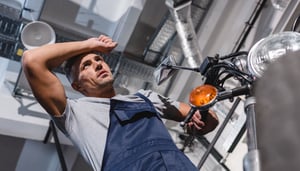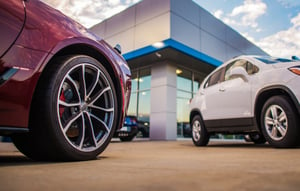
Why No Shorts in the Shop?
Every year Loss Prevention gets calls from members asking about wearing shorts in the shop.
PARTNER SPOTLIGHT
Dealer Management System, Computer Technology, Media/Advertising, Automotive Auction, F & I/Aftermarket Products, Automotive Technology Training & Compliance
 A NHADA Gold PARTNER
A NHADA Gold PARTNERComputer Technology, Automotive Shop Equipment, Environmental Services
 A NHADA Platinum PARTNER
A NHADA Platinum PARTNERF & I/Aftermarket Products, Automotive Technology Training & Compliance, Environmental Services
.png?width=150&name=corp_logo_horz_on_light_with_trademark_symbol_1200w%20(002).png) A NHADA Diamond PARTNER
A NHADA Diamond PARTNERWe have always cautioned members that, aside from the heat, it is safer for technicians to wear pants that protect the legs.
Due to the high volume of hazards that are presented through the use of pneumatic tools, welding, grinding, as well as the spraying of hazardous chemicals; the extra protection that pants provide is crucial in keeping you safe while performing these tasks.
Nonetheless, during the hot summer months, members need to be concerned about the potential for heat stress, heat exhaustion, and heat stroke.
Signs of heat stress include dizziness, weakness, vision problems, cramps, and nausea. Heat stress can escalate into more serious conditions.
Signs of heat exhaustion include excessive sweating, chills, clammy skin, extreme weakness, and rapid pulse.
Heat stroke is life-threatening and requires prompt medical attention.
Even though shorts provide some relief from the heat, there are measures that can be taken to keep techs from being overheated while still staying safe.
Your employees should:
- Drink plenty of water or other non-caffeinated beverage. Caffeine acts as a diuretic and can cause the body to deplete fluids faster. Techs should drink fluids throughout the workday even if they are not thirsty.
- Use fans, cool rags, etc. to lower your body temperature.
- Avoid eating big meals as they can cause the body to divert blood away from the skin where it cools the body.
- Avoid alcohol, caffeine, and allergy medicines, which can increase the risk of heat stress. Also, certain medical conditions; i.e., high blood pressure and diabetes, make you more prone to heat stress.
This would be the standard that OSHA could cite for wearing shorts when there are hazards present:
Application. Protective equipment, including personal protective equipment for eyes, face, head, and extremities, protective clothing, respiratory devices, and protective shields and barriers, shall be provided, used, and maintained in a sanitary and reliable condition wherever it is necessary by reason of hazards of processes or environment, chemical hazards, radiological hazards, or mechanical irritants encountered in a manner capable of causing injury or impairment in the function of any part of the body through absorption, inhalation or physical contact.
The reason why we advise against shorts is to ensure that all techs are being protected to the fullest extent possible from all potential hazards. The types of hazards that are present include, but are not limited to; shrapnel, hot pieces of metal or equipment as well as chemical splashes and burns. Although the temperature extremes during this time of year present an uncomfortable challenge, wearing pants provides a barrier of protection for all employees in the shop.
If you have any questions, please feel free to contact me at mfoster@nhada.com. Reach any other member of the Loss Prevention Department at 800-852-3372.



















.png?width=150&name=Ally_Final%20Logos%20and%20Pairings_11.14.2018-01%20(2).png)


-2.png?width=150&name=Wipfli%20Logo%20Blue%20RGB%20(1)-2.png)


.jpg?width=150&name=NHADA_Partner_FTR_Img_NHADA_Insurance%20(1).jpg)


.jpg?width=150&name=NHADA_Partner_FTR_Img_JMA(1).jpg)

